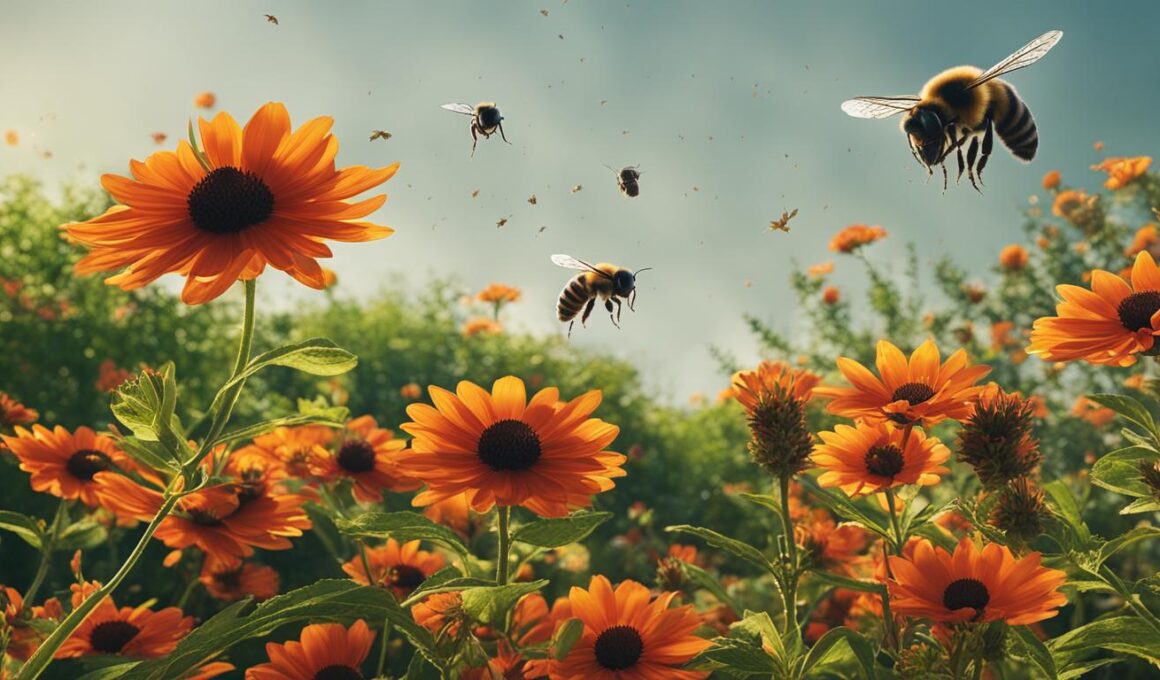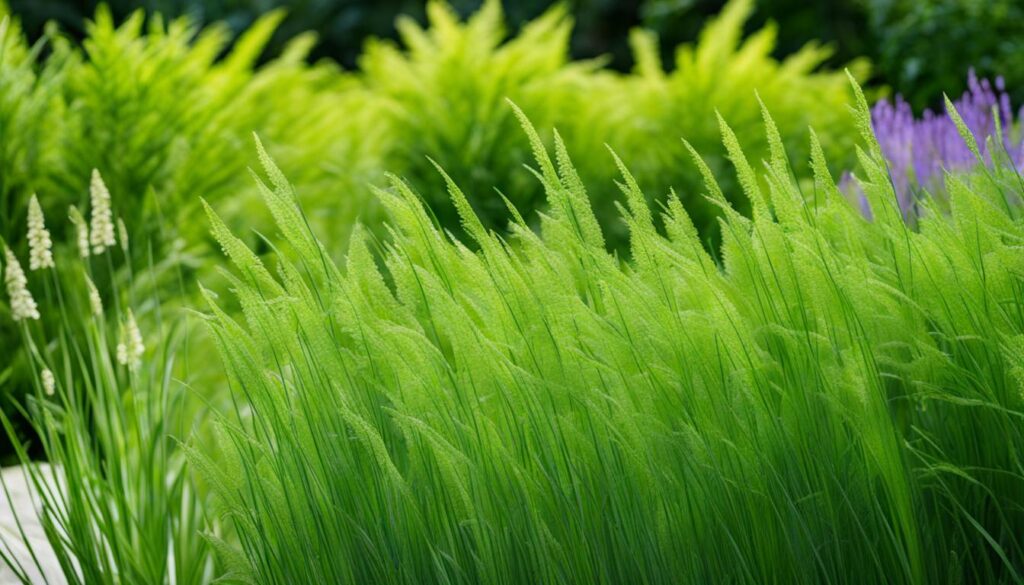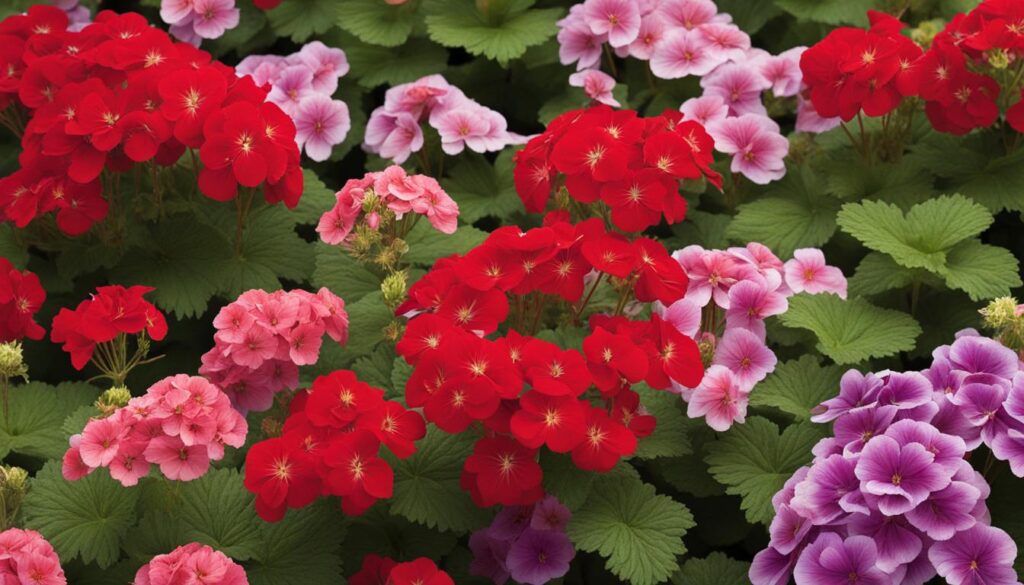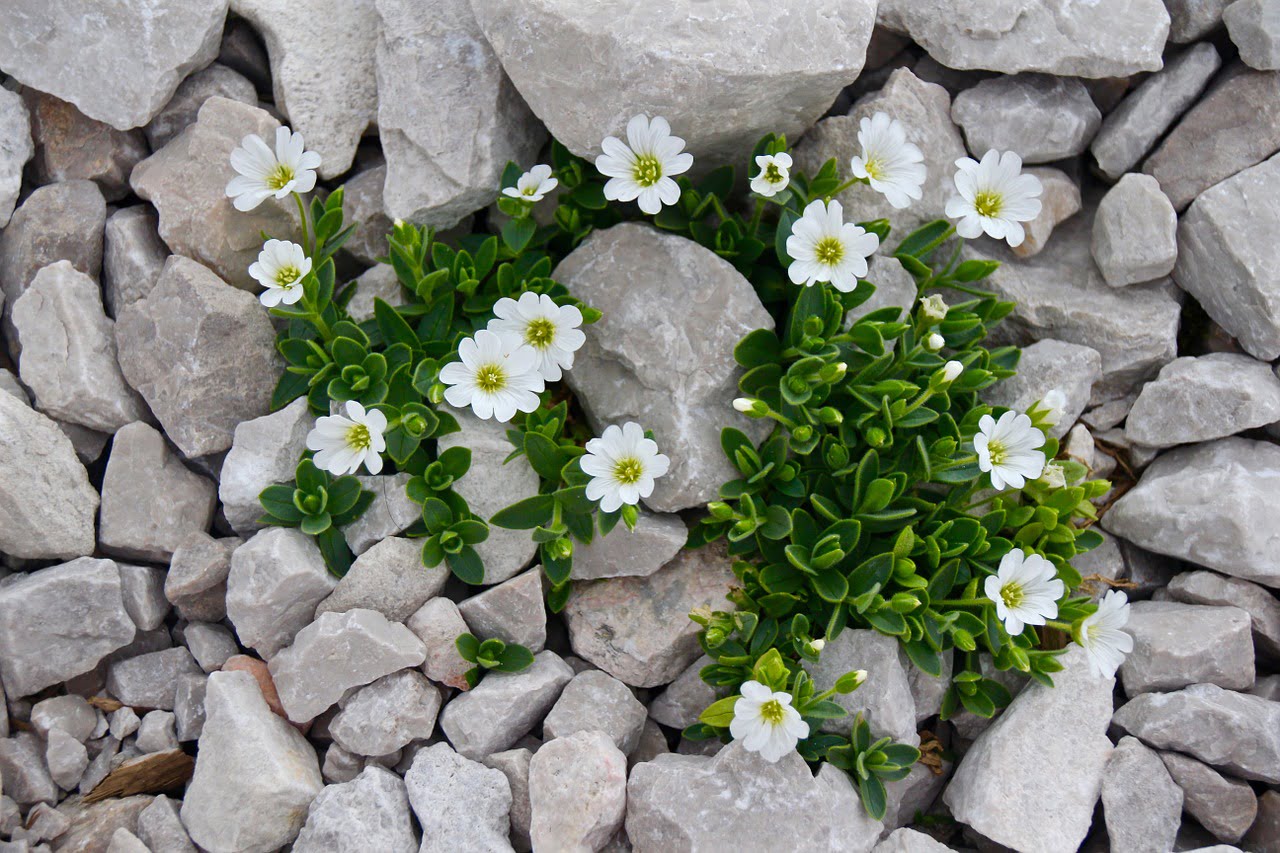In your quest for a bee-free garden, it’s important to know which plants bees don’t like. Whether you have allergies or simply want to avoid the risk of stings, incorporating bee repellent foliage can help create a safer outdoor space. While most flowering plants attract bees for pollination, there are certain plants that emit fragrances or possess qualities that bees find unattractive. By strategically choosing these plants, you can deter bees from specific areas and enjoy your garden without the buzzing presence of these flying insects.
Key Takeaways:
- There are plants that repel bees due to their scents, colors, or characteristics.
- Basil, citronella, geraniums, marigolds, roses, and wormwood are examples of plants that can repel bees.
- These plants may still attract other pollinators, so use them strategically to create bee-free zones.
- Always choose plants that are not harmful to bees and other pollinators.
- Research and plan your garden to create a harmonious balance between plants and beneficial insects.
Basil
Basil is a versatile herb that is commonly used in cooking, but did you know that it can also repel bees? While basil can attract honey bees when it’s in bloom, its scent when not flowering is not attractive to bees. This makes it a great choice for planting in your garden if you want to deter bees from specific areas or create a bee-free zone.
Basil belongs to the mint family and has a strong aroma that humans find pleasant, but bees find unappealing. By planting basil strategically, you can help keep bees away from areas where they may be a nuisance or a concern, such as seating areas or outdoor dining spaces. Plus, growing your own basil provides you with a fresh and flavorful herb to enhance your culinary creations.
To incorporate basil into your garden as a bee repellent plant, you can grow it in pots or directly in the ground. It thrives in well-drained soil and requires plenty of sunlight. Be sure to pinch off any flowers that may form to prevent attracting bees and to encourage bushier growth. Consider planting basil near other plants that bees are attracted to, as it can help divert their attention away from those areas.
Basil is not only a useful herb in the kitchen, but it can also serve as a natural deterrent for bees. Its ability to repel bees makes it a valuable addition to any garden or outdoor space where you want to minimize bee activity. So go ahead and plant some basil today to enjoy its culinary benefits and keep bees at bay!
Bee Repellent Foliage: Plants Bees Don’t Like
When it comes to creating a bee-free zone in your garden, citronella is a powerful weapon in your arsenal. Not only is it renowned for repelling mosquitoes, but its unique fragrance also has a repelling effect on wasps and bees. To make the most of citronella’s bee-repelling properties, it’s crucial to prevent the plant from reaching the bloom stage. By regularly pruning the plant, you can ensure that it remains in a state where its aroma is most effective at deterring bees. Additionally, you can harness the power of citronella by using its essential oil to create DIY citronella candles, further enhancing your efforts to keep bees at bay.
Geraniums are another excellent choice for repelling bees. Their strong scent is off-putting to many insects, including bees. In particular, red geraniums excel at repelling bees as these insects perceive the color red as black, which is not inviting to foraging workers. Consider growing geraniums in pots and strategically placing them in seating areas or along walkways where you want to deter bees. Their pungent odor acts as a natural barrier, ensuring that bees keep their distance from these areas.
Additional Bee-Repelling Plants
- Marigolds: These pungent flowers are often used as companion plants to deter insects. Their strong odor can also discourage stinging insects, including bees. However, keep in mind that marigolds themselves are not particularly attractive to bees, as they have little pleasing fragrance and pollen. They may not deter honey bees from visiting your garden if other nectar sources are available.
- Roses: While roses are beloved for their beauty, they are not as enticing to honey bees. Opting for red or other dark-colored varieties and avoiding highly scented roses can help reduce the number of bees around your rose bushes. However, it’s essential to note that bees may still visit roses for their nectar and pollen, especially if they have a strong preference for specific flower types.
- Wormwood: This herbaceous perennial is known for its potent scent that repels most insects, including bees. While it doesn’t offer anything of interest for hungry insects, it may need support from other foliage as it tends to sprawl and fall down later in the summer. Consider growing wormwood as an ornamental plant to naturally deter bees from your garden.
By strategically incorporating citronella, geraniums, marigolds, roses, and wormwood into your garden, you can create a bee-free zone or deter bees from specific areas. Remember to do your research and choose plants that are safe for bees and other pollinators. While it may be challenging to completely eliminate bees from your garden, these bee-repellent plants can be valuable tools in creating an environment that is less inviting to these buzzing insects.
Geraniums: A Natural Repellent to Keep Bees Away
When it comes to creating a bee-free zone in your garden, geraniums are an excellent choice. These vibrant flowers not only add color and beauty to your outdoor space but also have a strong scent that is off-putting to bees. Their naturally repelling properties make them an ideal plant for seating areas, walkways, or any area where you want to deter bees.
One of the reasons geraniums are effective in repelling bees is their scent. The aroma they emit is overpowering for many insects, including bees. Their strong fragrance acts as a deterrent, making bees less likely to venture near. Additionally, red geraniums are particularly effective because bees perceive the color red as black, which is not inviting to foraging workers.
Geraniums have a strong scent that is off-putting to many insects, including bees.
Geraniums are easy to grow and can be planted in pots or directly in the ground. They thrive in sunny locations and require well-draining soil. By strategically placing geraniums around your garden, you can create designated bee-free areas without the need for chemical repellents.
Benefits of Using Geraniums to Repel Bees:
- Strong scent that repels bees
- Red geraniums are particularly effective
- Easy to grow and maintain
- Create bee-free zones in your garden
- No need for chemical repellents
Next time you’re planning your garden, consider including geraniums as part of your strategy to repel bees naturally. Not only will they add beauty to your outdoor space, but they will also help create a more peaceful environment where you can relax and enjoy the outdoors without the presence of bees.
Marigolds: Bee Repellent Plants for Your Garden
Marigolds are not only beautiful additions to your garden but also effective at repelling bees. These vibrant flowers have a pungent odor that bees find unappealing. Planting marigolds strategically can help create bee-free zones in your outdoor space.
“Marigolds are often used as companion plants in the garden to deter insects, but they also discourage stinging insects from hanging around due to their pungent odor.”
While marigolds themselves may not be particularly attractive to bees, it’s important to note that honey bees may still visit the garden if they have other nectar sources available. However, the strong scent of marigolds can discourage bees from lingering and foraging in areas where you want to keep them away.
Marigolds are easy to grow and come in a variety of colors, adding a vibrant touch to any garden. They are versatile plants that can be planted in pots, flower beds, or used as borders. Additionally, marigolds are known for their ability to repel other insects like mosquitoes and aphids, making them a valuable addition to any pest management strategy.
Key Points:
- Marigolds repel bees due to their pungent odor.
- Plant marigolds strategically to create bee-free zones.
- While marigolds may not be attractive to bees, they can still visit if other nectar sources are available.
- Marigolds are easy to grow and come in a variety of colors.
- They also repel other insects like mosquitoes and aphids.
Roses
Roses, with their vibrant colors and delicate petals, are often favored in gardens for their beauty. However, if you’re looking to create a bee-free zone, certain varieties of roses can be a good choice. Bees are not particularly drawn to roses, especially if you opt for dark-colored varieties like red roses. Bees are sensitive to smells, and highly scented roses can be more enticing to them. By choosing roses with less fragrance, you can reduce the likelihood of attracting bees to your garden.
It’s important to note that while roses may not be as attractive to honey bees as other flowering plants, they can still provide nectar and pollen that bees need for sustenance. If bees have a strong preference for certain flower types or if there is a scarcity of other nectar sources, they may still visit your rose bushes. However, by selecting roses with less appealing scents and colors, you may see fewer bees around your garden.
Creating a Bee-Friendly Garden with Roses
- Choose dark-colored roses: Opt for red or other dark-colored roses, as bees perceive the color red as black, which is not inviting to foraging workers.
- Avoid highly scented roses: Select roses with less fragrance to minimize their attractiveness to bees.
- Provide alternative nectar sources: Plant other flowering plants that bees prefer to divert their attention away from roses.
- Strategically place roses: Consider planting roses away from seating areas or walkways where you want to minimize bee activity.
“Roses come in many different varieties and colors, but they are not very attractive to honey bees. By choosing roses with less appealing scents and colors, you may see fewer bees around your garden.”
Remember, while roses may repel bees to some extent, they can still attract other pollinators such as butterflies and hummingbirds. It’s crucial to create a balanced garden that provides a variety of plants to support different pollinator species. By selecting the right roses and integrating them strategically into your garden, you can enjoy the beauty of these blooms while minimizing bee activity in specific areas.
Wormwood: A Natural Bee Repellent Plant
If you’re looking for a plant that repels bees, wormwood is a great choice. This herbaceous perennial emits a strong odor that is not appealing to bees, making it an effective natural repellent. Unlike other plants that may deter bees with their scents or colors, wormwood goes a step further by noticeably repelling most insects, including bees.
Wormwood can be grown as an ornamental plant in your garden, adding a touch of beauty while keeping bees at bay. Its unique fragrance is not offensive to humans, but it effectively discourages bees from visiting. This makes it a useful plant for creating bee-free zones in specific areas of your garden where you want to enjoy your time without the presence of bees.
It’s important to note that wormwood does not offer anything of interest to hungry insects as it is wind-pollinated. This means that the plant doesn’t produce nectar or pollen that would attract bees. However, as wormwood tends to sprawl and fall down later in the summer, it may need support from other foliage to maintain its upright growth.
Benefits of Wormwood as a Bee Repellent Plant
- Effectively repels bees and other insects
- Adds beauty to your garden as an ornamental plant
- Creates bee-free zones in specific areas
- Does not produce nectar or pollen to attract bees
Wormwood is a natural bee repellent that emits a strong odor that bees find unappealing. It can be grown as an ornamental plant to add beauty to your garden while deterring bees from specific areas. With its wind-pollinated nature and lack of nectar or pollen, wormwood provides an effective solution for keeping bees away.
Conclusion
To naturally repel bees from specific areas of your garden, consider planting certain types of plants that bees don’t like. Basil, citronella, geraniums, marigolds, roses, and wormwood are examples of plants that can help deter bees due to their scents, colors, or characteristics.
While these plants may still attract other pollinators, strategically using them can create bee-free zones. It’s important to note that these plants should not be harmful to bees or other pollinators. Do your research and choose plants that are safe for the environment.
By incorporating bee repellent foliage, you can enjoy your garden without the constant presence of bees. However, it’s important to remember the vital role that bees play in pollination and the overall health of ecosystems. Be mindful and aim to strike a balance between creating bee-free zones and providing a welcoming environment for these important pollinators.
Are There Any Overlapping Plants and Flowers that Repel Bees in Both North America and the US?
Yes, there are several bee repellent flowers for garden in both North America and the US. Some examples include marigolds, mint, and lavender. These plants not only add beauty to your garden but also help repel bees due to their strong scents, making them a great option for those looking to deter bees.
FAQ
Can these plants completely eliminate bees from my garden?
While planting certain types of plants can help deter bees from specific areas, it may be difficult to completely eliminate bees from your garden. Bees play a crucial role in pollination, so it is important to create a balance that supports both the needs of the bees and your garden.
Do these plants repel other pollinators?
These plants may deter bees, but they may still attract other pollinators such as butterflies and beneficial insects. It is important to be mindful of the potential impact on all pollinators and choose plants that are not harmful to them.
How should I use these plants to repel bees?
You can strategically plant these bee-repellent plants in specific areas of your garden or create bee-free zones. For example, you can plant basil or citronella to deter bees from seating areas or walkways. However, it is important to ensure that there are still suitable nectar and pollen sources nearby for the bees to forage.
Can bees still visit these plants for nectar and pollen?
Bees may still visit these plants for their nectar and pollen, especially if they have a strong preference for certain flower types. While these plants may make the area less attractive to bees, they may not completely discourage them from visiting if they have other food sources available.
Are these plants harmful to bees or other pollinators?
It is always best to do your research and choose plants that are not harmful to bees or other pollinators. While these plants may repel bees, they should not pose a threat or cause harm to them. Be mindful of using pesticides or other chemicals that could be detrimental to pollinators.












